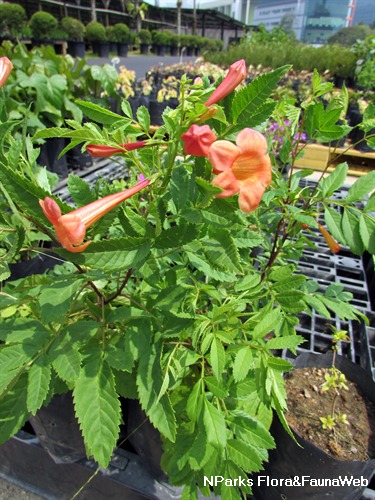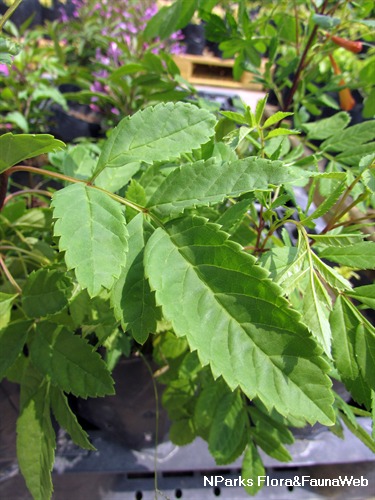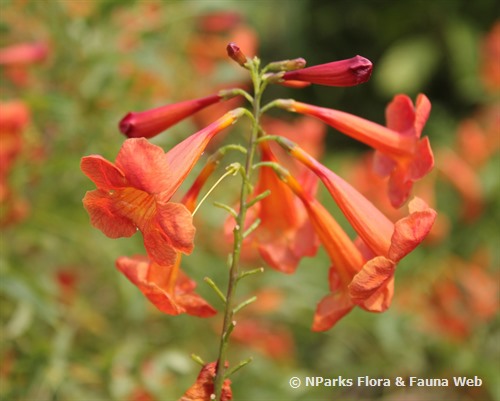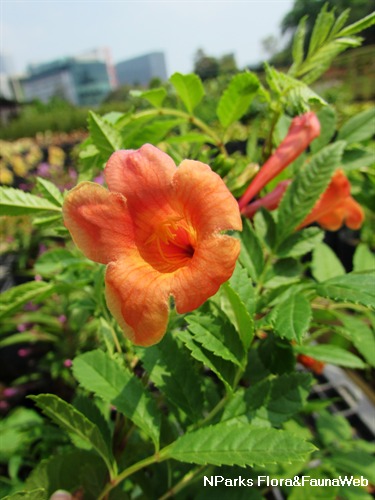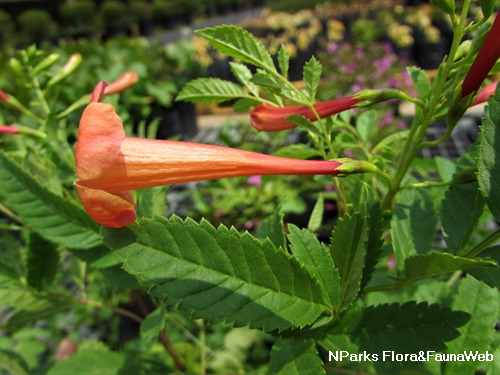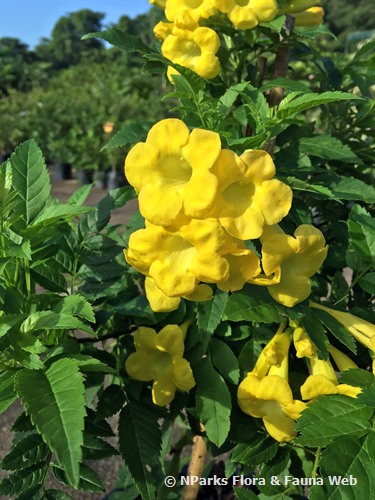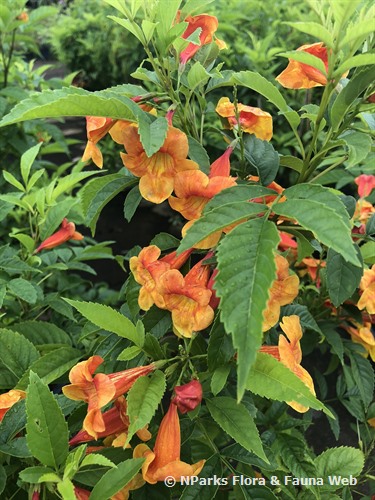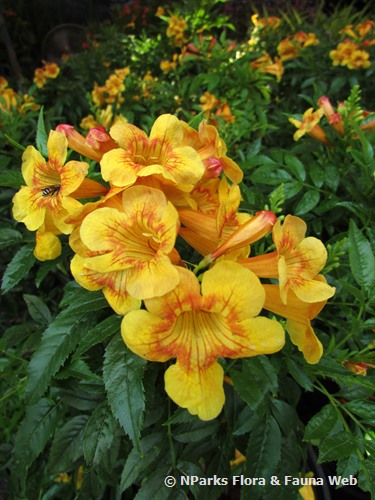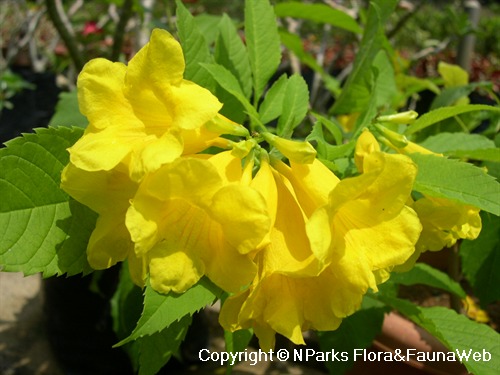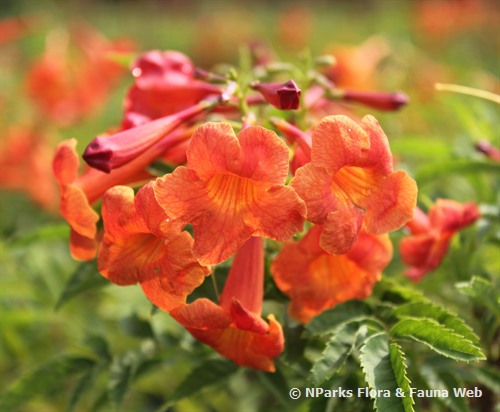
Back
Tecoma fulva (DC.) J.R.I.Wood subsp. guarume
| Family Name: | Bignoniaceae |
| Synonyms: | Tecoma guarume DC., Tecoma alata DC. |
Name
Classifications and Characteristics
| Plant Division | Angiosperms (Flowering Seed Plants) |
|---|---|
| Plant Growth Form | Shrub |
| Mode of Nutrition | Autotrophic |
Biogeography
| Native Distribution | Peru |
|---|---|
| Native Habitat | Terrestrial |
| Local Conservation Status | Non-native |
Description and Ethnobotany
| Growth Form | Tecoma fulva ssp. guarume is a semideciduous, glabrous shrub 1.2 to 3 m tall. |
|---|---|
| Foliage | Leaves are opposite and pinnate. There are 5 or 9 (rarely 11) leaflets in each leaf (10–15 cm long). Leaflets, about 1–3 cm long and 0.5–1.5 cm wide, are glabrous; and obovate to obovate-elliptic. Terminal leaves are larger than laterals, and sometimes lobed. Petioles (1–2 cm) and rachis are winged. Leaf margin is obscurely dentate, and branches are purplish. |
| Flowers | The inflorescence is a terminal raceme, occasionally branching basally to form a panicle. Each raceme has 10 to 20 flowered. Flowers are salverform-tubular and regularly widened from the base. Corolla is 5–6.5 cm long. Reddish orange petals fused to form a 4.5–6.0 cm tube with a mouth (1 cm wide) and 5 yellowish-orange lobes of 0.5 cm long. Flowers are bisexual. Stamens elongate to the mouth of the tube and filaments are of equal length. Stigma is 2.2 to 2.5 mm wide with two flattened lobes. Glabrous calyx is cup-like (3.5–6 mm long, 2 to 3 mm wide) and acutely 5-lobed. |
| Fruit | Fruits are capsular and bivalved, 5.5–7 cm long, 6–8 mm wide. Seeds are thin and two-winged. |
| Habitat | Dry forest region of Peru, where it grows between 100 m to 1200 m elevation range. |
Landscaping Features
| Desirable Plant Features | Ornamental Flowers |
|---|---|
| Landscape Uses | Parks & Gardens, Small Gardens |
Fauna, Pollination and Dispersal
| Fauna Pollination Dispersal Associated Fauna | Bird-Attracting |
|---|---|
| Pollination Method(s) | Biotic (Fauna) (Vertebrates (Bird)) |
Plant Care and Propagation
| Light Preference | Full Sun |
|---|---|
| Water Preference | Moderate Water |
| Rootzone Tolerance | Well-Drained Soils |
| Propagation Method | Seed |
Foliar
| Foliage Retention | Drought / Semi-Deciduous |
|---|---|
| Mature Foliage Colour(s) | Green |
| Mature Foliage Texture(s) | Smooth |
| Foliar Type | Compound |
| Foliar Arrangement Along Stem | Opposite |
| Foliar Attachment to Stem | Petiolate |
| Foliar Shape(s) | Non-Palm Foliage |
| Foliar Margin | Dentate |
Non - Foliar and Storage
| Root Type | Underground |
|---|
Floral (Angiosperm)
| Flower & Plant Sexuality | Bisexual Flowers |
| Flower Colour(s) | Orange |
|---|---|
| Flower Grouping | Cluster / Inflorescence |
| Flower Location | Terminal |
| Individual Flower Shape | Tubular |
| Inflorescence Type | Panicle |
Image Repository
Others
| Master ID | 32276 |
|---|---|
| Species ID | 6684 |
| Flora Disclaimer | The information in this website has been compiled from reliable sources, such as reference works on medicinal plants. It is not a substitute for medical advice or treatment and NParks does not purport to provide any medical advice. Readers should always consult his/her physician before using or consuming a plant for medicinal purposes. |

